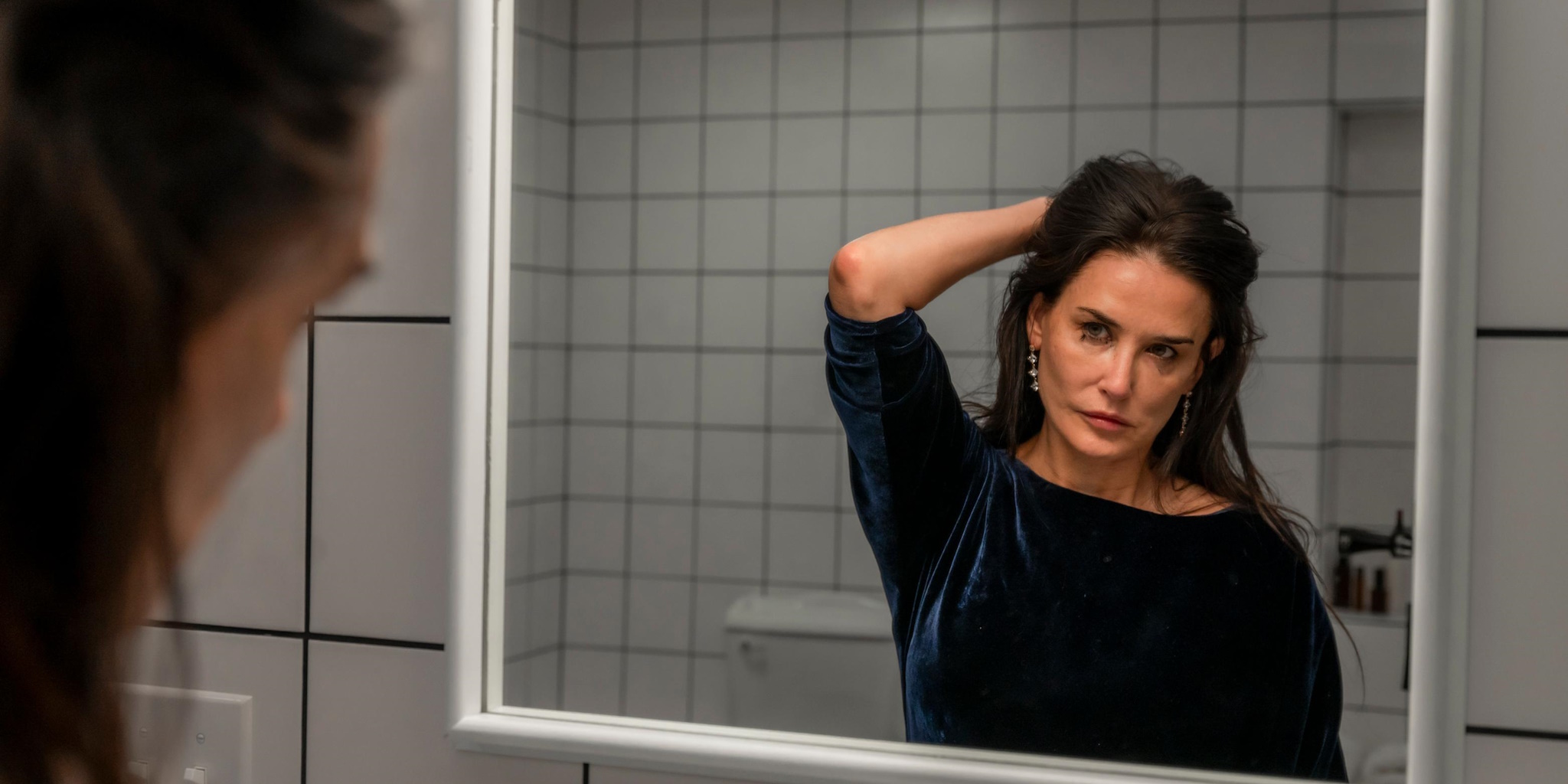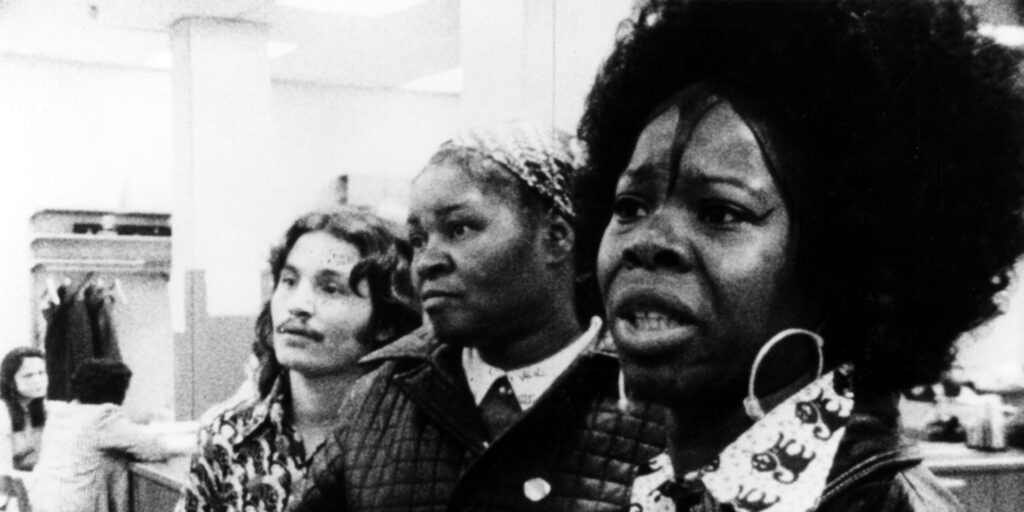A feature-length Tales from the Crypt episode that mashes up The Picture of Dorian Gray, All About Eve (1950), and Death Becomes Her (1992) into an orgiastic body-horror fable, Coralie Fargeat’s demented sophomore feature, The Substance, is not interested in half-measures. The director’s overcranked style is as unremitting as a double bump of uncut Bayhem, and her satirical skewering is about as subtle as an axe-crazy Joan Crawford. In an era when the austerity of tastefully restrained art-horror can at times approach self-parody, there’s something undeniably zesty about such an unapologetically disgusting (and horny) film walking away with the Best Screenplay Award at Cannes. Granted, that same festival bestowed the Palm d’Or on the car-fucking, gender-bending Titane (2021) just three years ago, but that feature is positively tony compared to the 141 minutes of glutinous madness that Fargeat gleefully force-feeds to her audience. Although the influence of David Cronenberg on The Substance is undeniable – particularly the filmmaker’s early works, such as Shivers (1975), Rabid (1977), and The Brood (1979) – there’s also plenty of daft, midnight-movie splatter energy in the mix, a la Larry Cohen, Stuart Gordon, and Peter Jackson. In other words, this is one for the sickos. (Yes… ha ha ha… Yes!)
Faded 1980s movie star and fitness icon Elizabeth Sparkle (Demi Moore, showing up hungry as a wolf for her hagsploitation era) was once on top of the world, but the ravages of time have taken their toll on both her celebrity and her once perfectly toned flesh. As The Substance never tires of reminding the viewer, Q Score and fuckability are often synonymous for women in show business. Elizabeth’s one steady gig now consists of hosting an (ahem) older women’s workout program, but her piggish producer, Harvey (Dennis Quaid, deliciously sweaty and loathsome), snatches away this last scrap of relevance under the pretense of retooling the show for a younger audience. Psychologically spiraling in the wake of this humiliation, she reaches out to the nameless purveyors of a black-market rejuvenation serum called the Substance. The product’s strange marketing doesn’t merely guarantee firmer skin and leaner thighs; it promises a whole “other self.”
Following a cryptic phone call with the company – there is no discussion of payment – Elizabeth retrieves her starter kit from a secure locker rather distressingly concealed in an anonymous skid-row alley. Along with various perplexing medical paraphernalia, the box contains a single vial of the chartreuse-green activator that will purportedly create a younger, sexier, and altogether better version of the user. (“ACTIVATE ONLY ONCE,” the kit’s packaging bellows in its alarming sans-serif lettering.) Once Elizabeth injects this serum, her 60-ish body ruptures to produce a mucus-slicked, 30-ish woman (Margaret Qualley) with a girl-next-door overbite and impossibly perky derriere. This newcomer, soon dubbed Sue, doesn’t remotely resemble a young Demi Moore, but no matter: Somehow, she is also Elizabeth, at least for the week that the older version of herself lies comatose in her apartment, sustained by an intravenous “food matrix.”
Luxuriating in her flexible, fresh-faced new form, Sue cheekily auditions to become the replacement host for Elizabeth’s former fitness show. The shamelessly lecherous Harvey is instantly smitten with her, and in short order Sue is promoted to Hollywood’s latest It Girl, her sparkly pink eyeshadow glinting from a thousand billboards and a million screens. However, there are a couple of hitches with Sue’s pharmacological devil’s deal. Every day, she must inject herself with a stabilizer fluid extracted from the spine of the stuporous Elizabeth. And every seven days, Sue and Elizabeth must switch places, to provide adequate time for the stabilizer to naturally regenerate. Lifting a page from the high-concept premise of Dan Erickson’s Severance (2022 – ), the two women are obliged to split a single consciousness, passing each other like ships in the night. While one body is active, the other lies in dreamless torpor, which results in mounting resentment as the two personas acclimatize to the challenges of their biweekly, time-sharing reality.
Stalking the apartment in her bathrobe, Elizabeth is forced to choke down her envy over the professional success and sexual attention that Sue is enjoying. It matters little that, as the Substance’s marketing makes clear, this dichotomy is ultimately illusory. (“There is no ‘she,’” the chilly voice on the customer-service hotline reminds Elizabeth. “You are one.”) It still seems like the smug, libertine Sue is getting away with something, absconding with the second chance that Elizabeth had sought for herself. Meanwhile, Sue grows contemptuous of the older woman’s self-loathing passivity, perceiving that half of “their” life is being wasted on junk food and daytime television. What’s the worst that could happen if she nicked an extra day or two of stabilizing serum from the unconscious Elizabeth? (Spoiler: Much, much worse than either woman can possibly imagine.)
Fargeat’s gore-spattered 2017 feature debut, Revenge, established her as one of most exciting genre filmmakers to emerge in the past decade. Reimagining the rape-revenge picture while maintaining its lowbrow essence, Fargeat marshaled an intense visual and aural aesthetic, an affinity for exploitation thrills, and a fearless employment (and subversion) of the male gaze. All of these traits are similarly in evidence in The Substance, which leans into the sheer fleshiness of its story with Troma-like gusto. Where another director might have gawked pornographically once or twice at Qualley’s glistening, writhing pelvis, Fargeat does it again and again (and again), until even the straight men in her audience are inclined to cough and avert their eyes uncomfortably. Meanwhile, the filmmaker regards her feature’s most revolting visual and makeup effects with a similar fascination, her camera rapt at the hideous beauty of edema, neoplasia, and necrosis. This is Fargeat’s fundamental, gut-churning magic trick: Zoom in close enough on one moist, quivering surface and it becomes indistinguishable from another, highlighting the absurdity of value judgments about this mortal coil. Tits are tumors, and tumors are tits.
The Substance has no use for nuance: It’s a film of bold, screeching gestures, every one cranked up to 11. Why spray your cast with 10 gallons of blood when you can use 1,000? Fargeat employs a manic, discombobulating assortment of visual techniques, but, as in Revenge, she’s particularly fond of off-putting, shallow-focus close-ups that emphasize the grotesqueness of the film’s world. The non-continuity editing – by the director, Jerone Eltabet, and Valentin Féron – is percussive and unrelenting (one might even say exhausting), exhibiting a music-video rhythm that harmonizes with the score by British electronic artist Raffertie. Sound designer/editor Valérie Deloof deserves special accolades for matching the relentless tempo of Fargeat’s action with an impressively aggressive soundscape, where even the tiniest actions seem to elicit nauseating squeals, scrapes, and squelches.
The setting that Fargeat has crafted is contemporary but also perplexingly retro at the margins, depicting a show business still dominated by network television, aerobics programs, and live New Year’s Eve specials. These anachronisms highlight that this is a campy caricature drawn by an outsider looking in at American culture. (Both stylistically and thematically, there are obvious similarities to Nicholas Winding Refn’s 2016 crypto-vampire fable The Neon Demon, although that film feels as tasteful and restrained as a black cocktail dress compared to Fargeat’s feature.) The Substance abounds in production-design details that don’t make a hell of a lot of sense when the viewer thinks about them for a moment or two. Why does the enormous billboard announcing Sue’s new show tower directly in front of the floor-to-ceiling windows of Elizabeth’s apartment, rather than facing toward the freeway? In the manner of Dario Argento or Brian De Palma before her, the filmmaker isn’t interested in what might be realistic: She only cares about whether something is evocative.
In The Substance, Hollywood is ugly, crass, and simplistic, a meat grinder that chews up beautiful young women and spits them out once they’ve reached their sexual expiration date. Although this is hardly an original observation for an artist to make, Fargeat presents it with furious aplomb, discovering a kind of sick charm in the audacity of systemic misogyny. The film’s male characters are almost all overeager twits and salivating trolls, and Quaid’s leering, polyester clown is their de facto king. The director often shoots Harvey in extreme close-up with a fish-eye effect, heightening his greasy monstrosity; the viewer can practically smell his hot breath, reeking of shrimp cocktail and cigarette smoke.
Quaid is a hateable delight, but what truly makes The Substance work – apart from Fargeat’s determination to take her premise to the absolute freakiest, EC Comics heights she can imagine – are the astonishingly game and unselfconscious performances from Moore and Qualley. Moore’s casting adds a splash of meta-textual acidity to the story, of course, but both actors are plainly relishing a chance to sink their teeth into something so unhinged. Elizabeth and Sue are tricky creatures, being at once monstrous and pitiable, but Moore and Qualley both navigate their roles nimbly. The latter has always excelled at portraying striving outsiders and disarming cuckoo-landers, but this feels like a proper late-career revelation for Moore, who hasn’t been this watchable since Margin Call (2011), and certainly not in a leading role since G.I. Jane (1997). The Bette Davis comparisons with Moore feel both inevitable and particularly on point, although there’s also a little Joan Crawford, Shelley Winters, and Elizabeth Taylor in there (the latter ca. 1973’s Night Watch).
Meanwhile, Fargeat herself is building on a rich tradition of body horror, sci-fi satire, and gothic-tinged exploitation cinema. The director’s influences are both broader and kookier than the obvious visual allusions to The Elephant Man (1980) or The Shining (1980) might suggest, betraying an evident fondness for Reagan-era gross-out features such as Basket Case (1982), The Stuff (1985), and Re-Animator (1985). Yet if Fargeat’s cinematic nostalgia is firmly grounded in the 1980s, her stylistic sensibilities are more contemporary, reflecting (and refracting) the post-MTV aesthetics of Michael Bay, Guy Ritchie, Park Chan-wook, and Sion Sono. To experience The Substance is to subject oneself to an incessant assault of sensations (and fluids), much as any woman who exists in any public space must endure a never-ending barrage of abuse and judgments. Usually on the subject of her fuckability.
The Substance is now playing in theaters.




